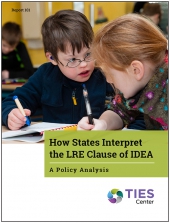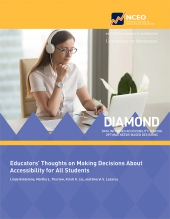Resources
Search Filters
Search Results
- Accommodations Considerations in Pre-College and Postsecondary Assessments for Deaf IndividualsFormats: PDF
This presentation focused on accommodations considerations in pre-college and postsecondary assessments for deaf individuals. It was presented at the 2019 Council for Exceptional Children (CEC) annual conference.
Published: 2019-01-30 - Pros and Cons of Alternate Diplomas: Benefits for Student Transition Success?Formats: PDF
This presentation describes the pros and cons of alternate diplomas, focusing on possible benefits for students to have successful transition experiences. It was presented at the 2019 Council for Exceptional Children (CEC) annual conference.
Published: 2019-01-30  NCEO Brief: Suggestions for Aligning Alternate Achievement Standards with WIOA (#16)
NCEO Brief: Suggestions for Aligning Alternate Achievement Standards with WIOA (#16)This Brief provides information on alternate achievement standards and the Workforce Innovation and Opportunity Act (WIOA) of 2014, and makes several suggestions about ways to show that a student who meets a state’s alternate academic achievement standards is on track to pursue postsecondary education or competitive integrated employment. Recommendations are also provided for states on how to build a strong system to support the realization of the intent of the Elementary and Secondary Education Act (ESEA) and WIOA requirements for their students with the most significant cognitive disabilities.
Published: January 2019 Making Decisions for Everyone Training ModuleFormats: Online
Making Decisions for Everyone Training ModuleFormats: OnlineThis online professional development module gives educators the knowledge and tools they need to make, implement, and evaluate sound decisions about accessibility features for students in their classrooms in situations teachers encounter across the school year. This self-paced module, developed by the Diamond Project, guides teachers through accessibility decision-making using a fun, interactive approach, focusing on one of three students: Beau (a student who is struggling with some reading-related tasks), Daisy (a student with an Individualized Education Program), or Ana (an English learner). The module, offered by the Minnesota Department of Education through the University of Minnesota, provides access to: reference materials, a set of post course group discussion questions, links to a YouTube collection of brief videos by NCEO experts contained in the online course, and a continually updated list of related videos produced by NCEO.
Published: 2019-01-06 Proceedings of the 1% Cap National Convening: Supporting States in Implementing ESSA's 1% State-level Cap on Participation of Students in the AA-AAAS
Proceedings of the 1% Cap National Convening: Supporting States in Implementing ESSA's 1% State-level Cap on Participation of Students in the AA-AAASThis Proceedings document was developed to provide a summary of the 1% National Convening that took place in Boston on October 18 and 19, 2018. More than 200 individuals gathered to listen to each other, share ideas, and develop state-level action plans. The purpose of the Convening was to support states as they work with local education agencies to implement the Every Student Succeeds Act (ESSA) requirement of a 1% cap on the participation of students with the most significant cognitive disabilities in the alternate assessment aligned with alternate academic achievement standards (AA-AAAS). The Proceedings document includes appendices and links to resources that were shared by states and others at the Convening.
Published: December, 2018 TIES Center Reports: How States Interpret the LRE Clause of IDEA: A Policy Analysis (#101)
TIES Center Reports: How States Interpret the LRE Clause of IDEA: A Policy Analysis (#101)The purpose of this report is to analyze how states interpret special education regulations associated with the Individuals with Disabilities (IDEA) regulations, specifically around least restrictive environment (LRE), the continuum of alternative placements, and placement for students with disabilities. Findings indicate that there was variation in how states organized the regulations. The interaction between policy and practice presents an on-going need for reevaluation of intent and praxis that has the potential to spotlight issues that may need to be addressed improve education and outcomes for students with disabilities.
Published: November 2018 TIES Center Briefs: 10 Reasons to Support Inclusive School Communities for ALL Students (#1)
TIES Center Briefs: 10 Reasons to Support Inclusive School Communities for ALL Students (#1)Educators, students, and families have found many compelling reasons to support inclusive education for students with and without disabilities. This Brief delineates ten reasons that supporting inclusive school communities for ALL students is important, but in a nutshell, inclusive learning communities are better, richer, and more effective when all students, including those with disabilities are full participants.
Published: November 2018- Using Online Professional Development Modules to Learn about Accessibility Features and AccommodationsFormats: PDF
This presentation explored using online professional development modules to learn about accessibility features and accommodations. It was presented at the 2018 Minnesota Department of Education's Minnesota English Learner Education conference (MELEd).
Published: 2018-11-17 - 1% Convening Webinar TrainingFormats: Online
This webinar provided information on how to be an effective facilitator at the 1% Cap National Convening.
Published: 2018-10-12  Guidance for Examining District Alternate Assessment Participation Rates
Guidance for Examining District Alternate Assessment Participation RatesThis Brief addresses important questions that arise for states as they implement federal alternate assessments aligned to alternate achievement standards (AA-AAS) participation requirements. Federal policy limits the number of students that a state may assess with an AA-AAS to no more than 1% of all students in the grades assessed in a state. The AA-AAS is intended only for students with the most significant cognitive disabilities. Given that many states report more than 1% of their student population taking an AA-AAS, there is a need to identify effective and technically defensible practices for monitoring participation rates for alternate assessments.
Published: October 2018- Guidance for Examining District Alternate Assessment Participation RatesFormats: PDF
This document provides states with effective and technically defensible practices for monitoring participation rates for alternate assessments at the district level to comply with the federal 1% policy limit on statewide alternate assessment participation for students with the most significant cognitive disabilities.
Published: 2018-10-01  NCEO Newsletter: October 2018 issueFormats: Online
NCEO Newsletter: October 2018 issueFormats: OnlineIn this issue, we highlight a report from the forum on speech-to-text and scribing that was held as a presession to the National Conference on Student Assessment. Several other NCEO reports are highlighted as well, including one on a literature review on measuring ELP progress of ELs with disabilities and ELs, one on publicly reported assessment results, and three on state assessment participation, performance, and accommodations data. Finally, this issue provides information on a new resource that is coming soon from NCEO's TIES Center, an Impact issue on inclusive education for K-8 students with the most significant cognitive disabilities.
Published: October 2018 Forum on Speech-to-Text and Scribing: Getting a Handle on What This MeansFormats: PDF
Forum on Speech-to-Text and Scribing: Getting a Handle on What This MeansFormats: PDFA report on a forum held on June 26, 2018 in San Diego, California that brought together staff from state departments of education, school districts, testing and testing-related companies, and other educational organizations to discuss speech-to-text and scribing, the differences in terminology, challenges associated with speech-to-text, and needed research. The forum was a pre-session to the Council of Chief State School Officers (CCSSO) National Conference on Student Assessment (NCSA), and was a collaboration of the Assessing Special Education Students (ASES), the State Collaborative on Assessment and Student Standards (SCASS), and the National Center on Educational Outcomes (NCEO). This report summarizes both the introductory information provided to forum participants, and the facilitated forum discussions that followed.
Published: September 2018- A Truly Inclusive Society: Encouraging the Ability in DisabilityFormats: PDF
This testimony was presented at a congressional briefing to the Helsinki Commission (Commission on Security and Cooperation in Europe).
Published: 2018-09-24 - A Truly Inclusive Society: Encouraging the Ability in DisabilityFormats: PDF
This testimony was presented at a congressional briefing to the Helsinki Commission (Commission on Security and Cooperation in Europe).
Published: 2018-09-24  Educators' Thoughts on Making Decisions About Accessibility for All Students
Educators' Thoughts on Making Decisions About Accessibility for All StudentsThis report describes the asynchronous online focus group activity of the Data Informed Accessibility - Making Optimal Needs-based Decisions (DIAMOND) project. The goal of conducting the focus groups was to gather in-depth information about teachers' experiences with accessibility features and accommodations in the classroom and on assessments. The results from the focus groups contribute to the project's development of guidelines for making informed decisions about accessibility features and accommodations.
Published: September 2018 ELPA21 White Paper: Developing an Alternate ELPA21 for English Learners with the Most Significant Cognitive DisabilitiesFormats: PDF
ELPA21 White Paper: Developing an Alternate ELPA21 for English Learners with the Most Significant Cognitive DisabilitiesFormats: PDFThis White Paper was developed as part of the commitment of the English Language Proficiency Assessment for the 21st Century (ELPA21) project to the development and implementation of an alternate ELP assessment for ELs with the most significant cognitive disabilities. The purpose of this White Paper is to propose steps that ELPA21 might take to ensure that it develops and implements a technically adequate and appropriate alternate assessment for ELs with significant cognitive disabilities. It also proposes a possible workplan and timeline for Alt-ELPA21 assessment development activities. This White Paper will undergo iterative revision by ELPA21 and review by its Technical Advisory Committee. The final White Paper will be the result of these processes and reviews.
Published: August 2018 NCEO APR Snapshot Briefs: 2015-2016 APR Snapshot #16: State Assessment Participation and Performance of Students Receiving Special Education Services (#16)Formats: Online
NCEO APR Snapshot Briefs: 2015-2016 APR Snapshot #16: State Assessment Participation and Performance of Students Receiving Special Education Services (#16)Formats: OnlineThis report provides a snapshot of the participation and performance of students receiving special education services in statewide assessments used for Elementary and Secondary Education Act (ESEA) accountability. Using federally submitted data for the 2015-16 school year, we present information on participation and performance in reading and mathematics statewide assessments administered to grade 8 students.
Published: July 2018 NCEO APR Snapshot Briefs: 2015-2016 APR Snapshot #17: Students in Special Education Receiving Assessment Accommodations (#17)Formats: Online
NCEO APR Snapshot Briefs: 2015-2016 APR Snapshot #17: Students in Special Education Receiving Assessment Accommodations (#17)Formats: OnlineThis report provides information on the number of students with disabilities receiving accommodations and the performance of these students on the general statewide assessment used for Elementary and Secondary Education Act (ESEA) accountability. Using federally submitted data from the 2015-2016 school year, we present information on accommodations for reading and mathematics statewide assessments administered to grade 8 students (and grade 4 to show a comparison to grade 8 data).
Published: July 2018 NCEO APR Snapshot Briefs: 2015-2016 APR Snapshot #18: AA-AAS Participation and Performance (#18)Formats: Online
NCEO APR Snapshot Briefs: 2015-2016 APR Snapshot #18: AA-AAS Participation and Performance (#18)Formats: OnlineThis report summarizes Alternate Assessment based on Alternate Achievement Standards (AA-AAS) data used for Elementary and Secondary Education Act (ESEA) accountability to measure the academic achievement of students with significant cognitive disabilities. Using federally submitted data from the 2015-2016 school year, we present information on the number of students participating in the AA-AAS and the performance of those students.
Published: July 2018